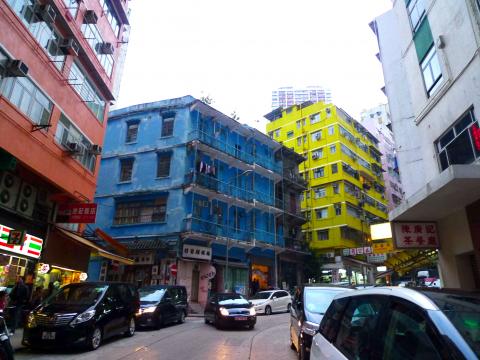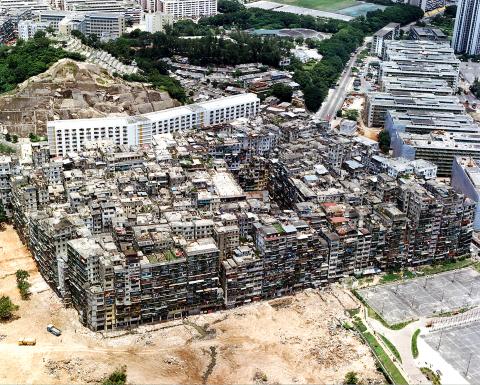Hong Kong is a global metropolis steeped in glitz and glamour, boasting chic shopping centers and multi-million dollar high-rise apartments. Yet at an exhibition about Hong Kong’s architecture held in Taipei last month, topics such as promoting the territory’s collective memory and preserving its heritage emerged as central themes among the group of Hong Kong architects and scholars attending the event.
And it seems that many citizens of the former British colony agree.
In January, the Hong Kong Architecture Center (香港建築中心) asked the public to vote for their favorite building. More than 15,000 Hong Kongers responded, and the results of My 10 Most “Liked” Hong Kong Architecture of the Century (十築香港—我最愛的香港百年建築) campaign were on display at the Past. Present. Future. — Tracking Hong Kong Architecture (築.跡—香港建築展), an exhibition organized by the Hong Kong Institute of Architects (香港建築師學會) to introduce people in Taiwan to a variety of related issues.

Photo courtesy of Hong Kong Institute of Architects and Hong Kong Architecture Centre
The top 10 works were not selected from a professional viewpoint; some were even built by local residents. Corrin Chan (陳翠兒), chairwoman of the Hong Kong Architecture Center, says that what makes a building stand out is its relation to local culture, communities and history and people’s everyday life.
The selected sites include Kowloon Walled City and the old Star Ferry Pier, both of which were demolished years ago.
“Through the campaign, we can see what is important to the people of Hong Kong… Some places no longer exist but they still made the list. It shows the power of memory,” Chan says.

Photo courtesy of Hong Kong Institute of Architects and Hong Kong Architecture Centre
HOME, SWEET HOME
The Kowloon Walled City, for example, serves as a metaphor for how people struggle to find a place to live in what is arguably the most densely populated place in the world. An enclave largely outside government enforcement, the walled city was built by those who lived there and controlled by organized crime syndicates.
“The place was rife with prostitution, crime and drug use. But people cherished the memory of the Kowloon Walled City because it shows our strength to survive even in the most difficult environment,” Chan says.

Photo courtesy of Hong Kong Institute of Architects and Hong Kong Architecture Centre
Public housing, which accommodates nearly 30 percent of the population, is another unique feature of Hong Kong’s urbanscape that was born out of necessity.
The history of public housing in Hong Kong began in 1953, when a devastating fire burned down a makeshift settlement. Some 50,000 people lost their homes and many perished in the inferno. Within a year, the first public housing project, Mei Ho House, was completed. It was followed by similar projects in the 1950s and 1960s.
Chan says that an extreme shortage of space meant there were no toilets or kitchens, though there was plenty of public space.
“People cooked in the corridor, kids ran around and their school was located on the rooftop. It created a closely-knit community,” she says.
Designated as a historic building, Mei Ho House became a youth hostel in 2013.
HERITAGE CONSERVATION
Stanley Siu (蕭國健) and Aden Chan (陳沛康), two young architects who co-curate the exhibition, say that heritage conservation is a relatively new concept.
Siu says that movements to preserve the old Star Ferry Pier and Queen’s Pier in 2006 and 2007 show that people have become aware of the importance of preserving Hong Kong’s heritage.
“Many young architects today share the same ideas about heritage conservation,” Siu says.
For example, there is a renewal project to restore a number of historic blue, yellow and orange houses in Wan Chai. Known as tonglau (唐樓, tenement buildings), these three to five-story buildings were built between the 1920s and 1950s — many to house post-war migrants from China.
The conservation project is the first of its kind in Hong Kong. Kenneth Tse (謝錦榮), an architect who runs the project, says it allows the original occupants to continue living in their homes, some of which have been passed down for generations.
“It marks a change in the way the government handles historic buildings. Before, residents would be relocated and developers built new buildings for profit and to promote tourism,” Tse says.
When the project is completed next year, the seven families living there will have their own toilets and kitchens.
Street level space will be rented out, providing services and job opportunities to those in the surrounding low-income neighborhoods.
“When preserving an old building, I think it is essential to look at the local culture, history and communities and try to find out how the new design can relate to locals and be incorporated into the local way of life,” Tse says.
Wang Wei-jen (王維仁), chair and professor of the Department of Architecture at University of Hong Kong, says that Hong Kong has faced an identity crisis since its handover to China in 1997. And the emphasis on preserving Hong Kong’s heritage and collective memory is part of the public’s desire to seek common roots.
“Having been ruled by different colonizers, people in Hong Kong started to ask who they are, like Taiwan did in the 1980s,” Wang says.
DEVELOPMENT CRAZE
A dearth of projects available to small and medium firms at home and China’s massive investment in its cities meant that a significant number of young Hong Kong architects began leaving in 1997.
Wang says 95 percent of the development projects in Hong Kong are either handled by the government or big developers.
“The land is very expensive, so each project needs to be a big project, whereas in Taiwan or Europe, they have big and small projects at the same time, giving young architects the opportunity to develop their skills,” Aden Chan says.
Meanwhile, skyrocketing real-estate prices means the government is looking for more land to develop in the more rural areas of the New Territories.
Aden Chan says his grandparents’ house in the New Territories is his favorite place in Hong Kong. But as the area is set for development, his childhood home is now empty; his grandparents moved out.
“The house is full of memories, where 50 years of life were lived there. We can’t really fight for it because the government says we have to leave. It is the real side of the powerless,” Aden Chan says.

Sept. 1 to Sept. 7 In 1899, Kozaburo Hirai became the first documented Japanese to wed a Taiwanese under colonial rule. The soldier was partly motivated by the government’s policy of assimilating the Taiwanese population through intermarriage. While his friends and family disapproved and even mocked him, the marriage endured. By 1930, when his story appeared in Tales of Virtuous Deeds in Taiwan, Hirai had settled in his wife’s rural Changhua hometown, farming the land and integrating into local society. Similarly, Aiko Fujii, who married into the prominent Wufeng Lin Family (霧峰林家) in 1927, quickly learned Hoklo (commonly known as Taiwanese) and

The low voter turnout for the referendum on Aug. 23 shows that many Taiwanese are apathetic about nuclear energy, but there are long-term energy stakes involved that the public needs to grasp Taiwan faces an energy trilemma: soaring AI-driven demand, pressure to cut carbon and reliance on fragile fuel imports. But the nuclear referendum on Aug. 23 showed how little this registered with voters, many of whom neither see the long game nor grasp the stakes. Volunteer referendum worker Vivian Chen (陳薇安) put it bluntly: “I’ve seen many people asking what they’re voting for when they arrive to vote. They cast their vote without even doing any research.” Imagine Taiwanese voters invited to a poker table. The bet looked simple — yes or no — yet most never showed. More than two-thirds of those

In the run-up to the referendum on re-opening Pingtung County’s Ma-anshan Nuclear Power Plant last month, the media inundated us with explainers. A favorite factoid of the international media, endlessly recycled, was that Taiwan has no energy reserves for a blockade, thus necessitating re-opening the nuclear plants. As presented by the Chinese-language CommonWealth Magazine, it runs: “According to the US Department of Commerce International Trade Administration, 97.73 percent of Taiwan’s energy is imported, and estimates are that Taiwan has only 11 days of reserves available in the event of a blockade.” This factoid is not an outright lie — that

The People’s Republic of China (PRC) yesterday paraded its military hardware in an effort to impress its own population, intimidate its enemies and rewrite history. As always, this was paced by a blizzard of articles and commentaries in the media, a reminder that Beijing’s lies must be accompanied by a bodyguard of lies. A typical example is this piece by Zheng Wang (汪錚) of Seton Hall in the Diplomat. “In Taiwan, 2025 also marks 80 years since the island’s return to China at the end of the war — a historical milestone largely omitted in official commemorations.” The reason for its